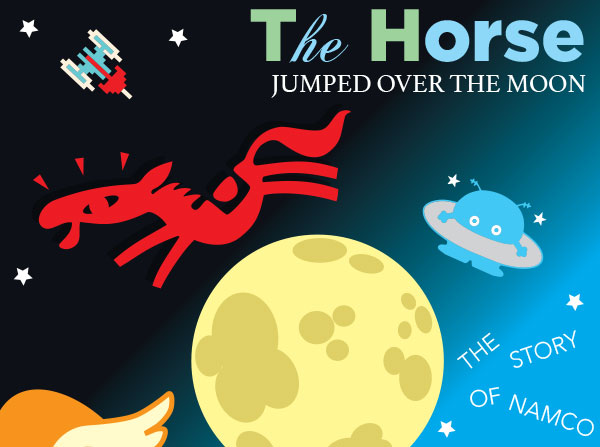
Namco’s Wonder Eggs opened in 1992, and the Egg Empire opened up in 1994. The game company made famous for creating Pac-Man, DigDug, Xevious, Pole Position, and a slew of other arcade classics managed to create two urban theme parks where play was the core experience. Both parks were popular with locals, and visitors from outside of Tokyo. Part of the reason why was because they tapped into timeless elements. Wonder Eggs was inspired in part by carnivals, amusement parks, pleasure fairs, and world’s expos of the past. These were similar to the things that influenced the creation of Disneyland. Their sister park across the street was decidedly more futuristic in origin. Namco looked at what the theme park experience might look like in the next millennium.
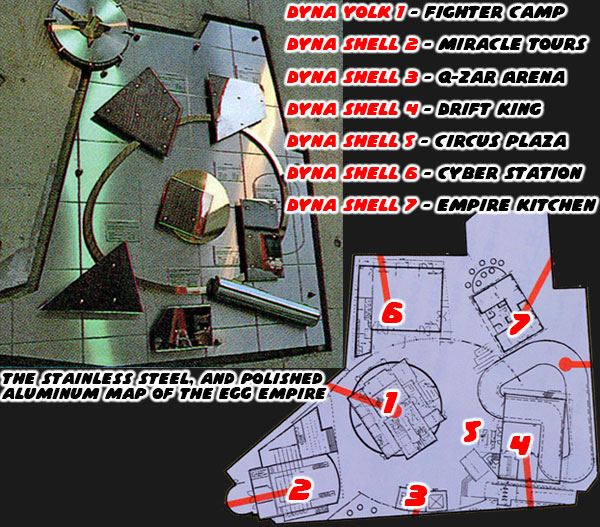
The Egg Empire was supposed to be more experimental, if anything I would liken it to a virtual theme park. There would be a lot of video game elements to this park. From top to bottom this park had an entirely metal facade. All of the buildings were painted in gray, black, and red. They looked as if all the architecture was carved out of a giant steel block with a laser cutter. It was a stark contrast from the wood, brick, and handmade quality of Laperot village. The concept behind the hangar-like buildings was sound. If an attraction needed repair, or replacement then they could simply close that particular building, and get to work. Namco really embraced the egg motif from both parks, but double so at the Empire. The center of the campus was called the “Dyna Yolk,” and the surrounding hangars were numbered “Dyna Shells.” Let’s talk about the central attraction.
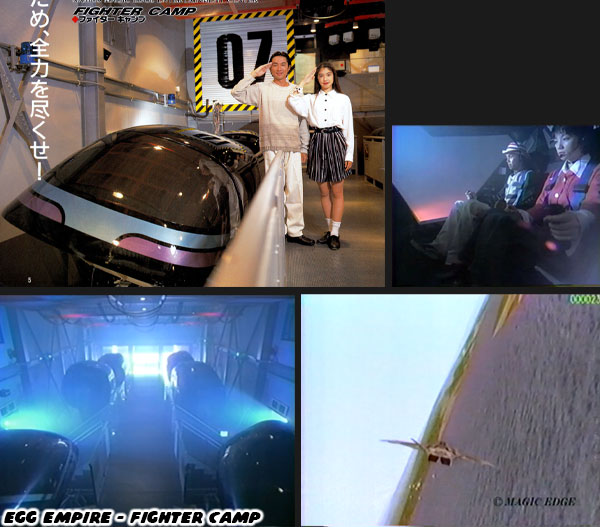
The Fighter Camp was a 40 minute experience. It was a fighter jet simulator that seated two players side-by-side in each cockpit. Dreamers would dress in flight suits, sit through a briefing, as if they were in the Top Gun academy. They would then get a short test flight in order to get used to the controls. They would then get called into service to enter a battle. They would be recorded, and get a debrief after their mission was concluded. From the description that I read about the attraction it was realistic, and at the same time difficult to control. This attraction was put together by Magic Edge in partnership with Namco. It used some cutting edge hardware, and software to build an experience that Namco would take to California later the same year. The Fighter Camp was one of the pricier experiences at the Egg Empire as well. It was charging dreamers 100 Eggs per session or ¥1000 Yen which was about $10 US
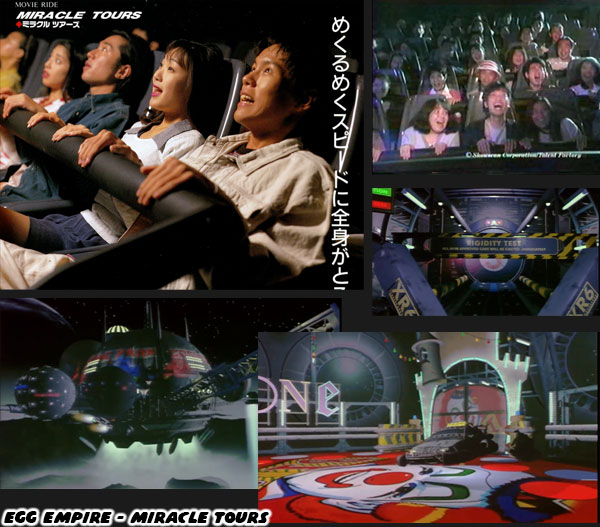
When I read the descriptions for each attraction I noticed that this park had an option for cash at each ride, instead of buying tickets at the gate. This was anathema to the magnetic Wonder Tickets sold at Wonder Eggs. It made me wonder if the business wing of Namco were playing armchair theme park designers. The attraction located in Dyna Shell 2 was called Miracle Tours. It was a movie ride recreating the sense of speed at different scales, including being bounced around on a pinball table. The CGI footage was created by Showscan Corporation/Talent Factory. Showscan had been building movie rides since 1985. Director, special effects expert and Showscan owner
Douglas Trumbull produced the show film. The ride system and its controls were later the basis for Disneyland's Star Tours ride. The specific ride at the Egg Empire was
Cosmic Pinball, and thankfully the reel was on YouTube. It was a 10 minute ride worth 50 Eggs.
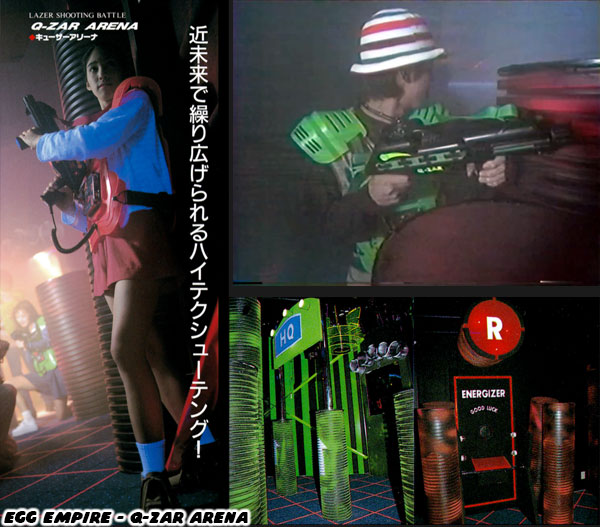
The attraction in Dyna Shell 3 was called the Q-Zar Arena. It was a massive laser tag game course. Laser Tag was a popular activity among kids, and there were many arcades that featured arenas to this day. The technology behind it actually stretched back to the 1970’s when it was used for US Army training exercises. As a toy it hit its peak in the 1980’s. The
history of Laser Tag according to Main Event was a fascinating read if you had the time. Visitors got armor, and laser rifles at the Q-Zar arena. Matches lasted 25 mins, and cost 50 Eggs. I noticed how little planning, and forethought the attractions had at the Egg Empire. It seemed like the people controlling the finances at Namco had gone through a catalog of amusement rides, and selected the cheapest ones that could fit within each hangar. That was not to say that the Miracle Tours, or Fighter Camp attractions were inexpensive. They probably cost a quarter-million dollars just to install. They were sadly forgettable rides, and not very cost effective as
Magic Edge went bankrupt a few years later in 1996. As far as park design went the Egg Empire seemed like a lazy cash grab.
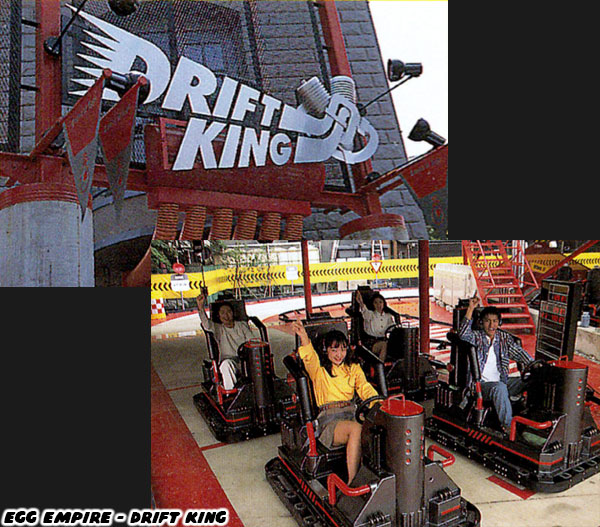
The designers at Namco were still working hard to create a theme, and aesthetic for the park, and its attractions. They needed to make sure they stood out from their peers. The goal was to make everything appear futuristic, and cutting edge. Just look at how they approached the attraction in Dyna Shell 4. The Drift King was a kart racing attraction on a slick course. In the mid ’90s drifting was starting to become popular. It was nothing new for the people at Namco.
They loved racing in all forms. The designers were turned on to street racing from the Megalopolis Expressway films from the ‘80s, and the Wangan Midnight manga, and anime of the ‘90s. So how could they turn a slippery kart race into a futuristic proving ground?
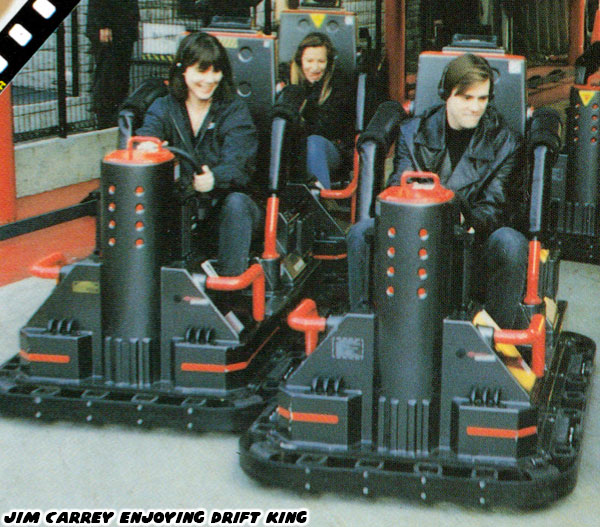
They gave each kart a visual makeover. The bodies now looked like some sort of cybernetic hovercraft. They also provided headsets to each racer. In this way they could communicate with each other, hear the lap counts, and more important so they could talk to their cars. The more vocally excitable you were during the race the more energy your ride had. If you yelled “turbo” then it would give you a short speed boost. It was the same bold approach that turned traditional bumper cars into
the Future Colosseum. The six-minute race was worth 50 Eggs like most of the experiences in this park.
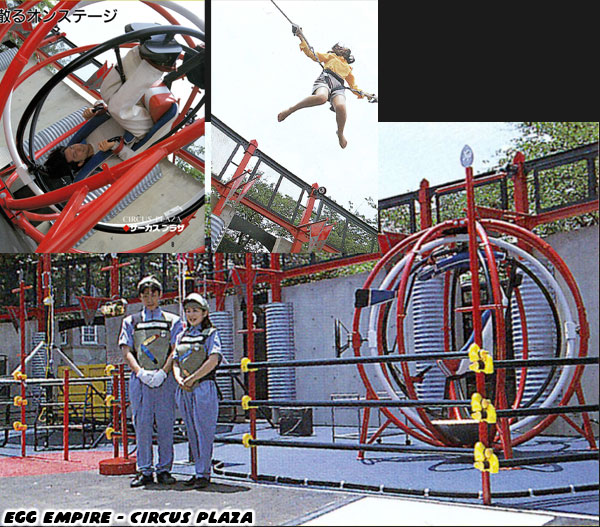
The remaining attractions filling out the Empire felt lacking. They were the kind of things you could find at a mall. For example Dyna Shell 5 had something called The Circus Plaza. It was an outdoor collection of tumbling equipment. A gyroscope, and bungee trampoline. It was 30 Eggs, or ¥300. I assume the experience ended when the guest got bored, tired, or injured with the equipment. Dyna Shell 6 had the Cyber Station II. This was an updated version of the arcade at Wonder Eggs. This one featured the latest games, and prize machines. It also featured networked cabinets, but I could not find out if it featured any gigantic games like Sim Road or Naviway. This arcade was the third location that accepted cash as well. Dyna Shell 7 contained a quick service restaurant called the Empire Kitchen.
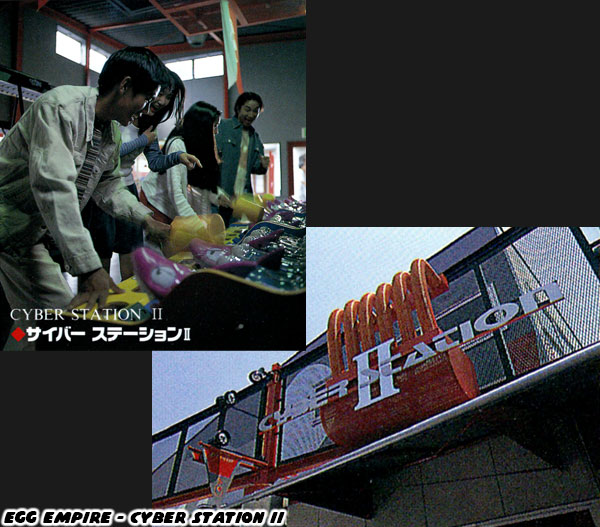
It took me about 10 blog entries to break down everything that went into the creation, and execution of Wonder Eggs. This post summed up the entirety of the Egg Empire. The attractions were nice, but not extraordinary. The elements of play that were the foundation of Wonder Eggs were lacking. There were no shows, no secret language, no rallies, or seasonal events to look forward to at the Egg Empire. Namco needed to make it more relevant to visitors or else it would close just as fast as it was built. We will look at what happened in the next blog. I hope to see you back for that. Were there any defunct parks that you visited? Please tell me about it in the comments section. As always if you would like to sponsor me
please visit my Patreon page and consider donating each month, even as little as $1 would help make better blogs and even podcasts!
Wonder Eggs, and Egg Empire research collected from: Wonder Eggs Guide Map, Namco Graffiti magazine, the book “All About Namco II", NOURS magazine, The Namco Museum, Namco Wiki, Ge-Yume Area 51 Shigeki Toyama Collection, mcSister magazine, first person attraction details from Yoshiki. Event details from Hole in the Socks.


















No comments:
Post a Comment